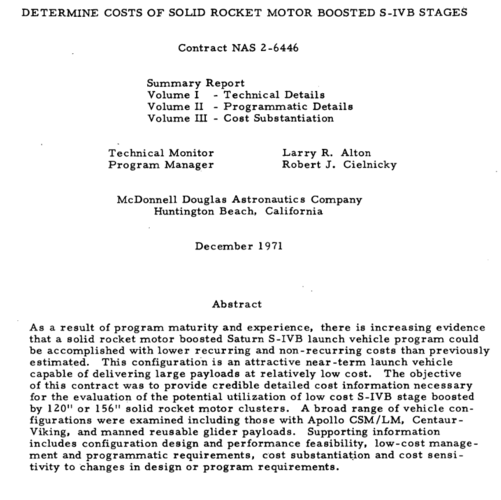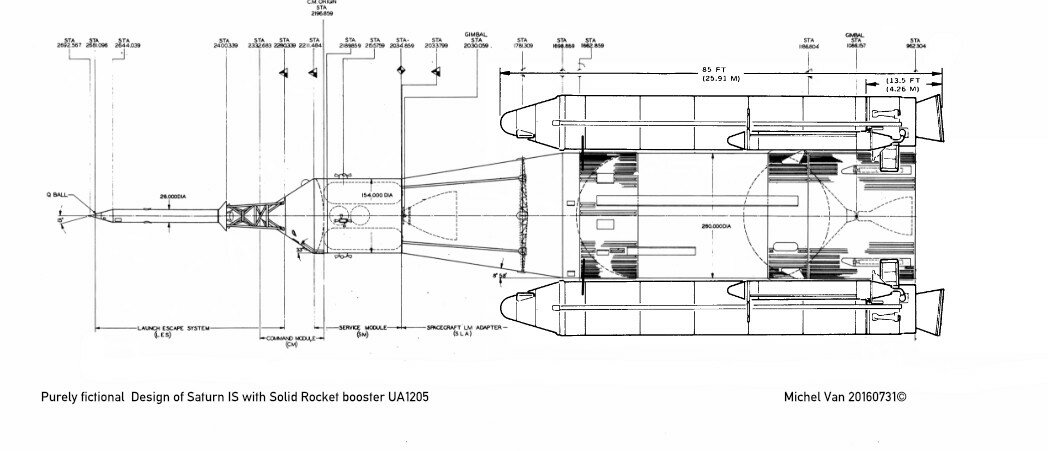Bouncing off @Byeman "unmanned flyback booster" thread. That's a different kind of reusable booster.
I've long been fascinated with that one. It is packed full with so much ironies, it could use some as propellant...
So, here we go...
1-Titan booster + Saturn stage = SATAN
2-According to Bellcomm it would have cost $260 a pound to orbit: the exact Space Shuttle cost target (!!)
(S-IVB was paid by Apollo, Titan SRM is a steel tube filled with fertilizer)
3-It could use LC-40 & 41, and the nearby LC-34, 37A and 37B (Titan III I-T-L & Saturn IB pads are very close at CCAFS)
4-It could be fully reusable TSTO: Titan solid recovered Shuttle-style; S-IVB recovered Philip Bono style
5- Fully reusable TSTO was the Shuttle objective (!!!)
6-Two Titan boosters with a S-IVB on top could lift 29.5 mt to orbit... the Shuttle very payload (USAF - NRO - KH-9 to polar orbit)
7-It could finish and test flight the XLR-129, which is SSME ancestor
8-Except XLR-129 was air started, because ISINGLASS / RHEINBERRY were to be air-launched from a B-52 wing pylon
9-In turn, this solves the Ares 1 issues (!!!!)
10-Because, indeed, such launcher looks like Ares 1 (with smaller solid(s) and a XLR-129 right between J-2 and SSME, see point 8 )
11-Even more if you use it to launch a Block III Apollo (Hello Orion my old friend...)
12-Which bring us to this - http://spaceflighthistory.blogspot.com/2015/11/a-bridge-from-skylab-to-stationshuttle.html
(Larry Alton, strike 1)
13-And then there is THIS (Larry Alton, strike 2)
14- Which mean that NASA, by December 1971, considered all the above points and an INTERIM program to bridge the ASTP - Shuttle gap, 1975-1978... oops, 1981. For the record, Nixon officially started and funded the Shuttle on January 5, 1972.

So, in summary: an alternate, no-Shuttle space program were the crew vehicle is Titan-SRM + S-IVB + Block III Apollo. That was dirt cheap compared to the Shuttle: around $1.5 billion in development cost. Versus $2.5 billion for Big Gemini, $3.5 billion for a "fat Dynasoar" Shuttle glider and $5.15 billion allocated to OTL barebone full size (15*60 ft payload bay) Space Shuttle.
I've long been fascinated with that one. It is packed full with so much ironies, it could use some as propellant...
So, here we go...
1-Titan booster + Saturn stage = SATAN
2-According to Bellcomm it would have cost $260 a pound to orbit: the exact Space Shuttle cost target (!!)
(S-IVB was paid by Apollo, Titan SRM is a steel tube filled with fertilizer)
3-It could use LC-40 & 41, and the nearby LC-34, 37A and 37B (Titan III I-T-L & Saturn IB pads are very close at CCAFS)
4-It could be fully reusable TSTO: Titan solid recovered Shuttle-style; S-IVB recovered Philip Bono style
5- Fully reusable TSTO was the Shuttle objective (!!!)
6-Two Titan boosters with a S-IVB on top could lift 29.5 mt to orbit... the Shuttle very payload (USAF - NRO - KH-9 to polar orbit)
7-It could finish and test flight the XLR-129, which is SSME ancestor
8-Except XLR-129 was air started, because ISINGLASS / RHEINBERRY were to be air-launched from a B-52 wing pylon
9-In turn, this solves the Ares 1 issues (!!!!)
10-Because, indeed, such launcher looks like Ares 1 (with smaller solid(s) and a XLR-129 right between J-2 and SSME, see point 8 )
11-Even more if you use it to launch a Block III Apollo (Hello Orion my old friend...)
12-Which bring us to this - http://spaceflighthistory.blogspot.com/2015/11/a-bridge-from-skylab-to-stationshuttle.html
(Larry Alton, strike 1)
13-And then there is THIS (Larry Alton, strike 2)
14- Which mean that NASA, by December 1971, considered all the above points and an INTERIM program to bridge the ASTP - Shuttle gap, 1975-1978... oops, 1981. For the record, Nixon officially started and funded the Shuttle on January 5, 1972.

So, in summary: an alternate, no-Shuttle space program were the crew vehicle is Titan-SRM + S-IVB + Block III Apollo. That was dirt cheap compared to the Shuttle: around $1.5 billion in development cost. Versus $2.5 billion for Big Gemini, $3.5 billion for a "fat Dynasoar" Shuttle glider and $5.15 billion allocated to OTL barebone full size (15*60 ft payload bay) Space Shuttle.
Last edited:

